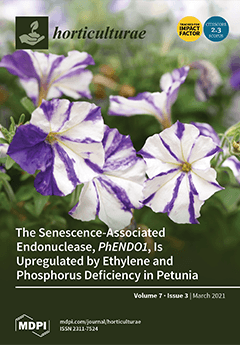Manglietia crassipes, a critically endangered species narrowly distributed on Mount Dayao in Guangxi, China, is also a species of ornamental interest whose variability has not been explored. Key factors leading to its endangerment have also not been studied. Here, two experiments were
[...] Read more.
Manglietia crassipes, a critically endangered species narrowly distributed on Mount Dayao in Guangxi, China, is also a species of ornamental interest whose variability has not been explored. Key factors leading to its endangerment have also not been studied. Here, two experiments were conducted to test the effects of different plant growth regulators and different storage conditions on germination characteristics of
M. crassipes seeds. Fruit morphology was measured, and germination characteristics of fresh mature seeds were tested in order to assess natural seed vigor. Seeds were soaked in distilled water (control), or gibberellic acid (GA
3), 6-benzylaminopurine (6-BA) or indoleacetic acid (IAA) solutions of different concentrations, for 48 h to determine their effects on seed germination. In addition, the effects of different seed storage conditions (constant 4 °C, −7 °C, −20 °C, or 25 °C for 100 days, wet stratification at 4 °C for 100 days) on seed germination were investigated. Results showed that the abortive rate of the mature fruits was high (28.9%) and fresh natural seeds had a low germination rate (G) and germination index (GI). Seed germination was inhibited with 6-BA at all concentrations, but only at less than 100 m·L
−1 IAA; otherwise, IAA slightly promoted seed germination. GA
3 broke seed dormancy and significantly accelerated seed germination by improving G, GI and initial germination time (IGT), especially over 2500 mg·L
−1. The viability of seeds declined no matter how they were stored. However, 4 °C wet stratification storage was preferable for seed vigor and germination power. Our results suggest that the high abortive rate of fruits, low germination of the natural seed, seed dormancy and its intolerance to storage, contributed to the endangerment of
M. crassipes. GA
3 can break
M. crassipes seed dormancy, which can be a benefit for future ornamental breeding and further protection or conservation.
Full article





